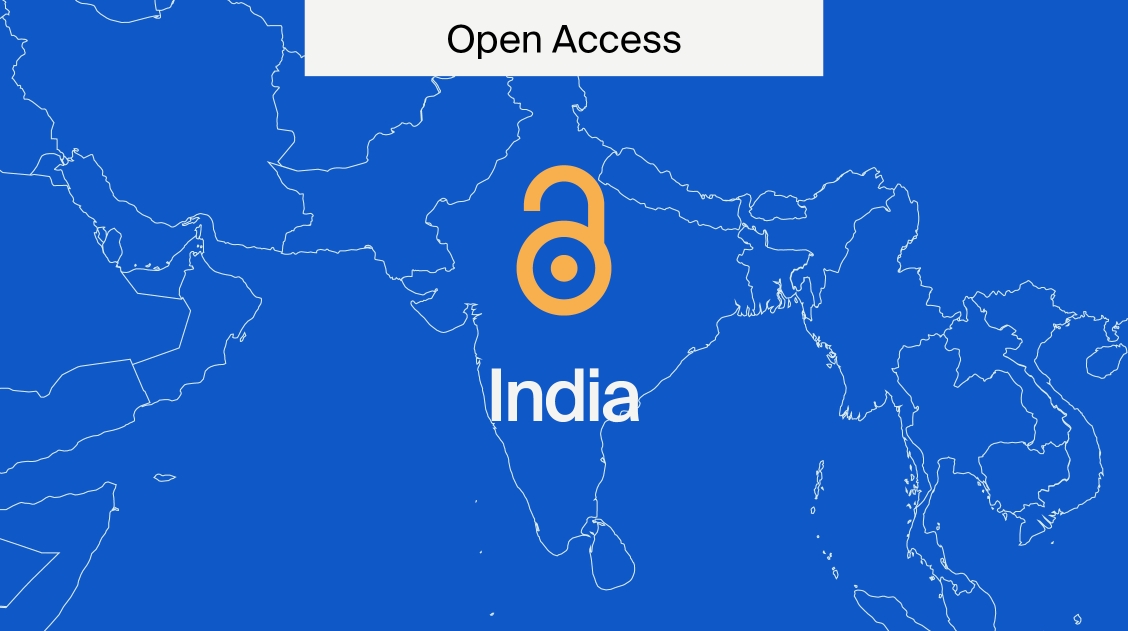
Open Access in India
India has a strong community-driven Open Access culture and serves as a research leader in the Global South. In 2025, they launched the One Nation, One Subscription model, providing access to research for 18,000,000 researchers.
We outline the history of Open Access in India and the current requirements for researchers.
Open Access is the new paradigm
Open Access (OA) refers to a publishing model for scholarly research that makes information immediately available to readers at no cost. This research is also free to reuse for scholarly purposes.
The benefits of publishing Open Access include gaining more citations and a greater impact, reaching a wider audience, advancing scientific innovation, retaining copyrights, and increasing the potential for collaboration and recognition.
Open Access can also help researchers affiliated to institutions and universities in low- and middle-income countries by removing any price barriers to accessing academic research.
History of Open Access in India
India has a long history of engaging with Open Access. Here is a brief history of Open Access in India, which we’ll expand upon further below:
- 2004: The S. Swaminathan Research Foundation hosted a workshop on OA recognising that, because of rising subscription costs, “Open Access will be of much greater advantage to India than to western countries”. Presentations focused on setting up institutional open archives like arXiv.
- 2006: A thinktank established to inform the prime minister on educational policy released the National Knowledge Commission recommendations, suggesting that providing access to knowledge will increase opportunities and promote innovation.
- 2011: This was an important year for Open Access in India:
- The Council of Scientific and Industrial Research (CSIR), among the largest publicly funded R&D organisations in the world, mandated that all papers supported by the CSIR must be made OA by depositing in an institutional repository.
- Open Access India launched. This is a platform for OA advocacy and influencing policymakers, researchers, and the scholarly community in India.
- Shodhganga, a digital repository for theses and dissertations submitted to Indian universities, was launched. This was in response to the 2009 University Grants Commission mandating that theses and dissertations must be made OA via repositories.
- 2013: The Indian Council of Agricultural Research (ICAR), the largest network of agricultural research and education institutes in the world, adopted a policy requiring all ICAR publications be made OA by depositing in institutional repositories.
- 2017: Open Access India submitted a draft OA policy to the government calling for a national OA policy.
- 2018: Led by Open Access India, the Delhi Declaration of Open Access showed solidarity in the Global South by advocating for the practice of open science, particularly through repositories.
- 2017 and 2019: The launch of the agriXiv and IndiaRxiv preprint repositories by the Open Access India community.
- 2024: IndiaJOL, a platform designed to support diamond Open Access journals, is launched by Open Access India.
Community-driven Open Access
India’s Open Access movement has largely been led by Open Access India, which has helped connect advocates, inform policy, and establish repositories for institutions and disciplines.
Open Access India are also responsible for both IndiaJOL and IndiaRxiv, providing community-hosted infrastructure that empowers Indian researchers to pursue open science.
Interestingly, India’s Open Access requirements have primarily revolved around green OA, which requires the depositing of preprints or complete manuscripts into repositories. This likely reflects the greater financial burden of other publishing models for Indian institutions and scholars.
Current Open Access laws in India
Currently, there is no nationwide Open Access mandate in India.
Researchers receiving funding and support from specific organisations, like the ICAR and CSIR, must deposit their work into repositories. Specific requirements vary between organisations.
However, there is government-level motivation to go further than green OA and create a centralised system.
Establishing an open science framework
The Science, Technology, and Innovation Policy 2020 aims to fundamentally change research in India.
Firstly, it established the Indian Science and Technology Archive of Research (INDSTA). This is an Open Access archive that serves as a centralised repository and hub for research within India’s Science, Technology, and Innovation community. It hosts research articles and data and showcases funding and job opportunities.
Similarly, the policy includes the One Nation, One Subscription policy (ONOS), which originally aimed for “all people in India” to have access to journal articles from around 70 publishers under a single negotiated payment made by the Government.
In 2024, the deal was agreed to provide access through a single portal to 13,000 e-journals from 30 publishers to around 18,000,000 students, faculty researchers, and scientists from across 6300 government-run higher education and research institutions. These institutions produce almost half of the country’s research papers.
This approach seeks to address the impact of high costs for access and fundamentally alter the relationship between traditional subscription publishers and national research communities. The deal is the largest of its kind in the world, and some of the funding will be used to cover the Article Processing Charges (APCs) of OA journals.
Overall, the Science, Technology, and Innovation Policy 2020 reflects India’s commitment to centralising its research infrastructure to improve access for all.
Growing importance of repositories
Primarily driven by Open Access India, there is a growing emphasis on submitting research to repositories.
Launching in 2019, IndiaRxiv is a national repository that accepts manuscripts and research materials from any discipline. It aims to improve the quality of science in the country, with all submissions being moderated.
IndiaRxiv accepts research written in English and all the Indian languages from Indian researchers working in India and abroad; further, it accepts research from non-Indian researchers creating works related to the country.
Research materials like research articles, review papers, datasets, monographs, and more can be submitted.
This empowers Indian researchers to share their work in a free and rapid manner, providing them with the necessary infrastructure to pursue open science.
Diamond OA
Also introduced by Open Access India is IndiaJOL, a diamond Open Access journal platform designed to support non-profit scholarly societies in India.
They explain:
We envision a future where Indian scholarly societies are empowered to publish high-quality research in an open and sustainable manner. IndiaJOL.org is committed to democratizing knowledge and promoting equitable access to research outputs through the tools and infrastructure of Diamond Open Access publishing.
The tool has a comprehensive range of services:
- Diamond OA journal hosting
- Technical support
- Global discoverability
- Publication standards
- Community building
As of December 2025, IndiaJOL does not list any journals on its website.
India Open Access statistics
Despite the growing Open Access culture in India, the percentage of subscription-only articles from the country remains high. Here are some statistics from Scopus:
- 2014: 76% of articles were subscription-only and 14% were gold Open Access.
- 2019: 71% of articles were subscription-only and 18% were gold Open Access.
- 2024: 73% of articles were subscription-only and 22% were gold Open Access.
Surprisingly, much of India’s research output remains subscription-only, with the share of closed access rising from 2019 to 2024. Researchers often face cost barriers for publishing OA and the Indian system for evaluating researchers relies heavily on Impact Factors, which may influence them to submit to older, more-established journals.
Future trends
India is among the top 5 research-producing countries, with its research output growing by around 54% between 2017 and 2022. However, much of this research is behind a paywall, limiting its impact and visibility.
The Science, Technology, and Innovation policy 2020 shows that India is committed to increasing access but may do it in a different way to countries in the Global North like those in the European Union, with Plan S requiring full and immediate Open Access.
This shows that the government recognises the different financial situation its researchers face than those in the Global North do. The Science, Technology, and Innovation policy reflects an impulse to centralise its research infrastructure and create access through alternative means before mandating an approach.
However, there has been criticism for how the One Nation, One Subscription model has diverted from its original aims. These particularly revolve around the costs, which rose from the original projections, and restricted access, which changed from the entire nation to government-run institutions.
The community-driven aspect of India OA movement grows stronger and continues to introduce community-hosted infrastructure. IndiaRxiv and IndiaJOL are two examples of how sustainable, non-profit initiatives can empower researchers to pursue open science.
As the influence of Open Access India grows, Indian science policy could embrace more green OA options, as in Japan which focuses on open repositories and data, and even adopt diamond OA models. These will help combat the prohibitive pricing of subscription fees.
Overall, India will need to adopt a unique approach to increasing access as it continues growing as one of the world’s leading producers of research. As a result, the country will continue serving as a model for other countries in the Global South.
Value of Open Access
All articles published by MDPI are made immediately available worldwide under an Open Access license. This means:
- Everyone has free and unlimited access to the full text of all articles published in MDPI journals;
- Everyone is free to reuse the published material if proper accreditation/citation of the original publication is given;
- Open Access publication can be supported by the authors’ institutes or research-funding agencies by payment of a comparatively low Article Processing Charge (APC) for accepted articles.
Researchers can satisfy India’s expanding Open Access policy and pre-empt any stricter legislation by publishing in an MDPI journal. Alternatively, if you want to publish an early version of your article, try Preprints.org, our service for publishing early versions of research that are not peer-reviewed and report on either ongoing or complete research.
Open Access makes vital information accessible to all readers and researchers and brings together scholars from across the world. Thus, it is ideal for tackling global challenges such as climate change and cancer research that require urgent and coordinated attention.
India is establishing its own unique approach to increasing Open Access in the Global South. Click here if you want to learn more about Open Access Around the World.










